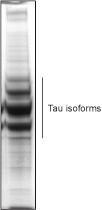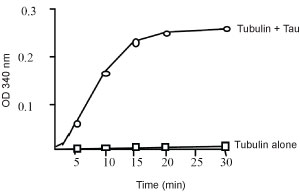Product Uses Include
- Positive control for the study of microtubule binding proteins
- Investigation of the the effect of Tau on microtubule dynamics
Material
Tau protein is isolated from MAP-rich bovine brain tubulin by ion exchange chromatography over a phosphocellulose matrix. The protein is supplied lyophilized. When reconstituted to 1 mg/ml (protein concentration determined by Precision Red Advanced Protein Assay, Cat. # ADV02), the protein will be in in 50 mM PIPES, 1 mM EDTA and 16 mM NaCl.
Purity
Purity is determined by scanning densitometry of proteins on SDS-PAGE gels. Samples are approximately 90% Tau proteins. Approximatley 1% contamination by high molecular weight MAPs and 9% other MAPs and non-MAP proteins.

Figure 1: Tau protein purity determination. A 10 µg sample of TA01 was separated by electrophoresis in a 12% SDS-PAGE system, and stained with Coomassie Blue.
Biological Activity
Biological activity of is determined by the ability of Tau protein to enhance the polymerization rate (Vmax) of purified bovine brain tubulin (Cat. # TL238) in vitro. Stringent quality control ensures that the Tau protein will stimulate tubulin polymerization approximately 20-fold when compared to tubulin polymerization without Tau fraction.

Figure 2: Tubulin polymerization in the presence and absence of Tau protein. Tubulin polymerization reactions were carried out as in BK006 with 3 mg/ml of pure bovine brain tubulin (Cat. # TL238) being polymerized in the presence and absence of 1 mg/ml Tau protein.
For product Datasheets and MSDSs please click on the PDF links below. For additional information, click on the FAQs tab above or contact our Technical Support department at tservice@cytoskeleton.com
Question 1: Which tau epitopes are phosphorylated?
Answer 1: Tau is a phosphoprotein with 79 potential serine and threonine phosphorylation sites on the longest tau isoform. Phosphorylation has been reported on approximately 30 of these sites in normal tau proteins. The tau protein we provide is from bovine brain (Cat. # TA01) and Coomassie Blue staining demonstrates multiple tau isoforms exist in the purified bovine tau, some of which are likely to be phosphorylated isoforms. The exact epitopes that are phosphorylated will need to be determined empirically.
Question 2: Will this bovine tau modify polymerization of tubulin from porcine?
Answer 2: Yes, the bovine tau (Cat. # TA01) will bind to porcine tubulin due to the high sequence homology of tau and tubulin between mammalian species. Upon binding to tubulin, polymerization is enhanced.
If you have any questions concerning this product, please contact our Technical Service department at tservice@cytoskeleton.com








